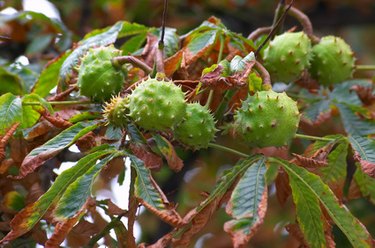
The American chestnut (Castanea dentata) and Chinese chestnut (Castanea mollissima) are commonly found throughout North America, and only a careful, practiced eye can tell the difference between the two. Chinese chestnuts are often grown commercially for their tasty nuts. The trees are a favorite among Northern gardeners because they are hardy and cold-tolerant. Learn the subtle differences between the American and Chinese chestnut trees to tell the two apart easily.
Leaves
Video of the Day
Look carefully at the leaves of a chestnut tree to discern whether it is American or Chinese. American chestnut tree leaves are narrow, with toothed edges that have a slight arch. Chinese chestnut trees grow leaves with fine, fuzzy hairs on the lower surface. The Chinese chestnut tree grows alternating, oblong leaves that have sharp, pointed teeth around the edges.
Video of the Day
Flowers and Nuts
Chestnuts on the American and Chinese chestnut trees grow in large, round burs that are spiny in appearance. On American chestnuts, the pods grow one-half to 1 inch in diameter; Chinese chestnuts grow slightly larger burs that are 1 to 1 1/4 inches in diameter. Chinese chestnuts grow flowers in large clusters. When the flowers are in bloom, they emit a strong, unpleasant odor.
Twigs and Branches
The twigs on an American chestnut tree have a brown color and smooth, hairless feel. Chinese chestnut tree twigs have a grayish tint to them. The twigs are also covered with fuzzy hairs, particularly near the tips. In winter, American chestnut trees may grow a slight fuzz of hair on the twigs and bugs, but the fuzziness is much more pronounced in Chinese chestnuts.
Bark
The bark of American chestnut trees will feel smooth to the touch and look reddish-brown to the eye. As the tree ages, flat ridges may appear on the surface of the bark. Chinese chestnuts grow grayish-brown bark that will become furrowed very quickly as the tree ages.
Appearance
American and Chinese chestnut trees grow differently. American chestnuts grow straight and upright, the foliage is more narrow than Chinese chestnut trees. The leaves and branches of the Chinese chestnut grow in a wider, spreading pattern.
- Northern Nut Growers Association: Identification of American Chestnut Trees
- Virginia Tech Department of Forest Resources and Environmental Conservation: How to tell the Difference Between American and Chinese Chestnuts
- Ohio Department of Natural Resources: Chinese Chestnut (Castanea mollissima)
- Connecticut Agricultural Experiment Station: Identification of Chestnut Trees